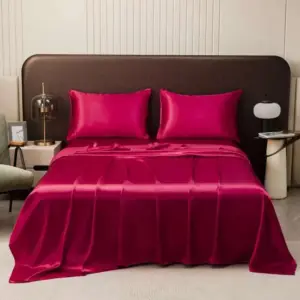Introduction: The Year-Round Versatility of Silk Bedding
Many people believe silk bedding is only suitable for certain times of the year – perhaps too cool for winter or too warm for summer. This common misconception overlooks one of silk’s most remarkable qualities: its natural ability to adapt to your body’s needs regardless of the season.
Silk is nature’s temperature regulator, a fabric that works with your body rather than against it. Unlike synthetic materials or even other natural fibers, silk possesses an inherent ability to maintain comfort in fluctuating temperatures. This special quality comes from silk’s unique protein structure, composed of fibroin and sericin, which allows it to respond differently to changing conditions.
Mulberry silk specifically stands out in the world of silk varieties, offering superior year-round comfort due to its exceptional quality and consistency. The premium Mulberry silk bedding sets provide a perfect balance of breathability in summer and insulation in winter, adapting seamlessly as seasons change.
For centuries, cultures across diverse climates have treasured silk for its versatility. From the scorching summers of ancient China to the cold winters of European royalty, silk has maintained its reputation as the ultimate comfort fabric. Understanding what makes Mulberry silk special helps explain how one fabric can excel in such varied conditions.
In this comprehensive guide, we’ll explore exactly how silk bedding adapts to each season, providing you with comfort all year long without the need to switch between different bedding materials.
Understanding Silk’s Natural Thermoregulation Properties
To appreciate why silk performs so exceptionally across seasons, we need to understand its unique physical structure. Unlike many fabrics, silk is composed of naturally occurring protein fibers with a hollow core. This unique composition is the foundation of silk’s remarkable temperature-regulating abilities.
The complete guide to Mulberry silk bed sheets explains that these hollow fibers create tiny air pockets that serve as natural insulators. These pockets trap warm air close to your body when temperatures drop but also allow excess heat to escape when temperatures rise. This is why silk feels cool against your skin on hot nights yet provides warmth during colder months.
Silk’s thermoregulation capabilities stem from four key properties:
- Breathability: The natural protein structure allows air to circulate freely, preventing the stuffy feeling common with synthetic materials.
- Moisture-wicking: Silk can absorb up to 30% of its weight in moisture without feeling damp, drawing perspiration away from your body.
- Insulation: The hollow fiber structure traps air, creating a natural insulating layer that maintains body heat in cooler temperatures.
- Humidity control: Silk naturally balances humidity around your body, creating an ideal microclimate for sleep.
What makes these properties truly remarkable is how they work automatically in response to your body’s needs. The temperature regulation of silk sheets happens at a molecular level, with the protein fibers responding differently depending on the conditions they encounter.
Premium Mulberry silk in the 19-25 momme weight range offers the optimal balance of these thermoregulating properties. This weight provides enough substance for effective insulation in winter without becoming too heavy for summer comfort.
Unlike synthetic materials that tend to either trap heat or feel cold, silk’s natural composition means it’s constantly working with your body’s temperature rather than imposing a fixed thermal characteristic. This adaptability is what makes silk truly unique among bedding materials and explains its year-round versatility.
Silk Bedding for Summer: Staying Cool and Dry
When temperatures rise and humidity levels climb, the right bedding becomes essential for quality sleep. This is when silk’s cooling properties truly shine.
During hot summer nights, silk’s natural breathability prevents the hot, sticky feeling often experienced with cotton or synthetic sheets. The smooth fiber structure allows air to circulate freely around your body, creating a naturally ventilated sleep environment. Unlike cotton, which tends to absorb and hold both heat and moisture against your skin, silk allows both to dissipate quickly.
One of silk’s most impressive summer qualities is its cooling touch. Silk naturally maintains a temperature 3-4°F cooler than cotton sheets, providing immediate relief when you slip into bed on a warm night. This cooling effect comes from silk’s highly efficient thermal conductivity – it quickly transfers heat away from hot areas (your body) rather than trapping it.
The exceptional cooling silk sheets also excel at moisture management, a crucial factor for summer comfort. When you perspire during sleep, silk wicks that moisture away from your skin almost immediately. Unlike synthetic materials that might feel clammy or cotton that absorbs moisture and stays wet, silk pulls moisture away while remaining relatively dry to the touch. This prevents that uncomfortable sticking sensation common with other fabrics.
Many hot sleepers report that switching to silk bedding has dramatically improved their summer sleep quality. By maintaining a cooler, drier sleep environment, silk helps avoid the disrupted sleep patterns common during hot weather. Studies show that sleeping in temperatures above your comfort zone increases wakefulness and decreases REM sleep – issues that silk bedding helps mitigate.
The lightweight nature of silk also contributes to its summer appeal. High-quality silk provides comfort without the heavy, trapped feeling of thicker materials. Many users find they can transform sleep quality with silk sheets alone in summer, eliminating the need for multiple layers or heavy covers.
Perhaps most surprisingly, silk’s summer cooling effect can even reduce reliance on air conditioning. By helping regulate your body temperature naturally, many silk users report being comfortable at slightly higher thermostat settings, potentially offering energy savings during peak cooling months.
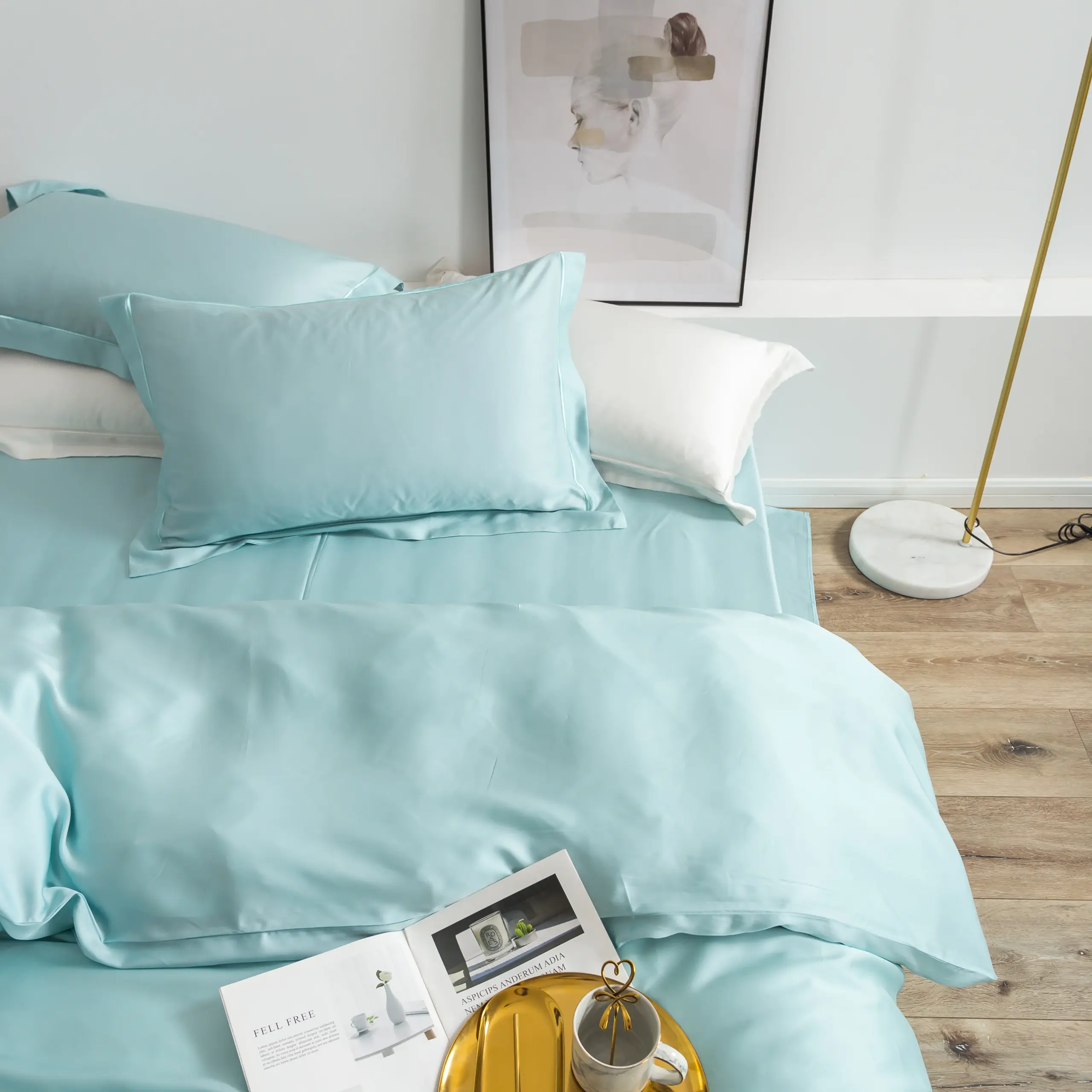
Silk Bedding for Winter: Staying Warm and Cozy
As temperatures drop, silk bedding reveals its remarkable versatility by transforming into an excellent insulator. Unlike synthetic materials that create warmth by trapping your body heat (often leading to overheating), silk provides a more sophisticated form of insulation.
The secret lies in silk’s unique fiber structure. The natural proteins in silk fibers create tiny air pockets that trap warm air close to your body – similar to how down functions, but with better moisture management. This creates a thin, insulating layer that maintains comfortable body temperature without the bulkiness of traditional winter bedding.
What truly sets silk apart from other winter bedding options is the quality of warmth it provides. Many people describe silk warmth as “breathable warmth” versus the “stuffy warmth” of synthetic materials or flannel. The advantages of sleeping on Mulberry silk include this distinctive quality – you feel cozy without that claustrophobic, overheated sensation.
Winter bedrooms often suffer from dry air due to heating systems, which can lead to static electricity in bedding. Silk’s natural moisture retention properties help counteract this dryness, reducing static and maintaining healthier skin hydration. This prevents the rough, dry skin that often plagues winter sleepers using cotton or synthetic sheets.
Another key winter benefit is silk’s ability to maintain consistent temperature throughout the night. Rather than experiencing the common cycle of too hot/too cold that disrupts winter sleep, silk sheets help maintain your body’s ideal sleep temperature. This temperature stability is particularly valuable for couples who may have different warmth preferences.
Perhaps most practically, silk’s insulating properties mean you can often use fewer layers during winter months. Instead of piling on multiple blankets that can feel heavy and restrictive, many silk users find they sleep comfortably with just their silk sheets and a lighter duvet. This “lightweight warmth” enhances sleep quality by allowing more natural movement throughout the night.
The winter benefits of silk extend beyond just temperature regulation. The smooth surface prevents the friction that can irritate dry winter skin, while its natural proteins help maintain skin moisture that heating systems often deplete. These combined benefits make silk an ideal winter sleep solution that addresses multiple cold-weather comfort challenges simultaneously.
Silk Bedding for Transitional Seasons: Spring and Autumn Adaptability
Spring and autumn present unique bedding challenges with their fluctuating temperatures and unpredictable weather patterns. One day might require summer-weight bedding while the next calls for winter warmth. This is where silk’s adaptive properties become particularly valuable.
During these transitional seasons, many people find themselves constantly adjusting their bedding – adding or removing layers as temperatures shift. Silk bedding eliminates much of this hassle by automatically adapting to both your body temperature and ambient room conditions. This responsiveness means your Mulberry silk sheets are good for maintaining comfort despite the temperature swings common in spring and fall.
Consider a typical autumn scenario: you go to bed with cooler evening temperatures but might experience warmer conditions by early morning as the sun rises. Cotton sheets that felt comfortable at bedtime may feel too cold initially and too warm later. Silk, however, will adapt throughout these changes, feeling pleasantly cool when you first lie down and providing just enough warmth as temperatures drop overnight.
Spring and fall also bring seasonal allergies for many people. Silk’s natural resistance to common allergens like dust mites, mold, and mildew makes it an excellent choice during these high-allergy seasons. The hypoallergenic properties of silk fabric provide relief when pollen and other allergens are at their peak, potentially helping reduce nighttime allergy symptoms that can disrupt sleep.
Morning dew and increased humidity common in transitional seasons are also effectively managed by silk’s moisture-regulating properties. Silk helps maintain the ideal humidity microclimate around your body regardless of whether the air is becoming more humid (spring) or drier (fall).
Perhaps most practically, transitional seasons don’t require you to swap out your bedding entirely. The same silk sheets, pillowcases, and duvet covers that kept you cool in summer will keep you warm in winter and perfectly balanced in between. This consistent comfort eliminates the need for seasonal bedding storage and reduces the total amount of bedding you need to purchase and maintain.
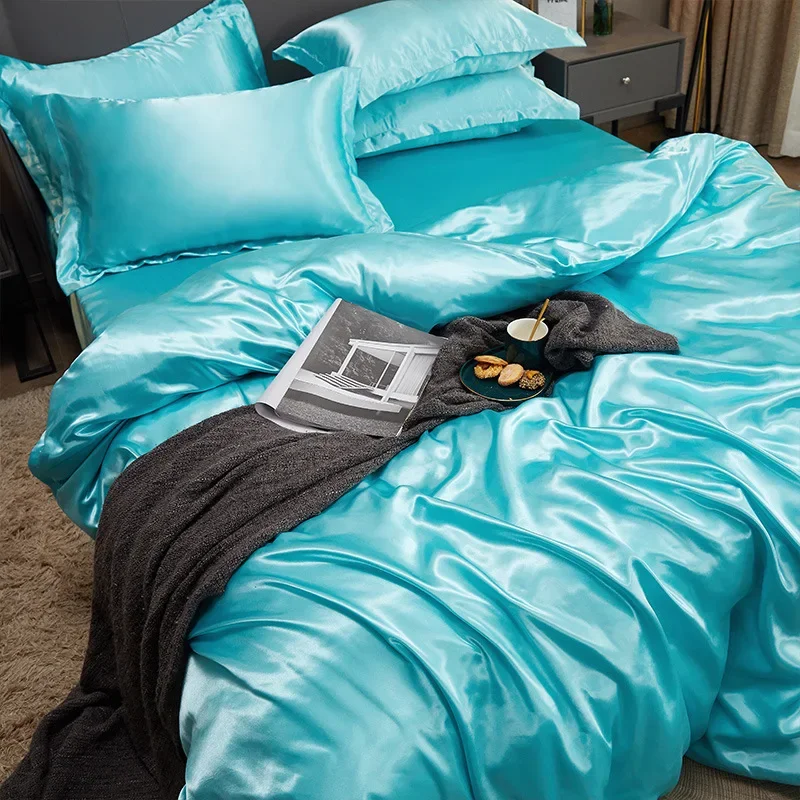
Layering Silk Bedding for Seasonal Adaptations
While silk bedding works beautifully across seasons on its own, strategic layering can enhance its performance for your specific comfort needs. Understanding how to combine silk with other materials and adjust your bedding configuration seasonally maximizes silk’s natural benefits.
During summer months, minimalist layering works best. Many people find that a simple combination of silk sheets with a lightweight silk duvet cover provides ideal cooling comfort. For the hottest nights, removing the duvet insert and using just the silk cover as a light blanket offers sufficient coverage while maximizing breathability. The smooth surface of silk prevents the “sticking” sensation common with cotton sheets in high humidity.
Winter calls for thoughtful layering that maintains silk’s breathability while adding warmth. Layering silk sheets with duvets creates an ideal winter sleep environment. Consider using silk sheets as your base layer, with a medium-weight duvet in a silk cover. This combination provides exceptional insulation without the bulkiness of traditional winter bedding. Some sleepers add a lightweight cashmere or wool blanket between the top sheet and duvet for extra warmth on the coldest nights.
For transitional seasons, adaptable layering proves most effective:
– Use silk sheets as your consistent base layer year-round
– Keep both lightweight and medium-weight covers accessible
– Consider a dual-layer duvet system where you can add or remove inserts as needed
– Maintain silk pillowcases consistently for hair and skin benefits regardless of season
Creating a year-round silk bedding set system eliminates the need for complete bedding swaps between seasons. Instead, simple adjustments to your layering approach allow you to fine-tune the thermal properties of your bedding as conditions change.
When selecting components for your layering system, consider how different momme weights complement each other. Lighter-weight silk sheets (19-22 momme) paired with a medium-weight duvet cover (22-25 momme) offer versatility across most climates. This combination provides the adaptability needed for year-round comfort with minimal adjustments.
The key to successful silk layering is maintaining the breathability that makes silk special. Avoid combining silk with synthetic materials that might trap moisture and counteract silk’s natural temperature regulation. Instead, pair silk with other natural fibers like lightweight wool, cashmere, or high-quality cotton for complementary performance.
Beyond Temperature: Additional Year-Round Benefits of Silk Bedding
While silk’s temperature-regulating properties are remarkable, its benefits extend far beyond seasonal comfort. These additional advantages remain consistent throughout the year, making silk an investment in overall well-being.
Silk’s hypoallergenic nature provides year-round protection against common allergens. Unlike cotton, which can harbor dust mites, mold spores, and other allergens, silk naturally resists these irritants. Its tightly woven structure and protein composition create an inhospitable environment for dust mites, while its moisture-wicking properties prevent the humidity that encourages mold growth. These properties make silk ideal for allergy sufferers regardless of season.
The skin benefits of silk are perhaps its most celebrated year-round advantage. Mulberry silk bedding’s skin benefits come from its exceptionally smooth fiber structure – up to 18 times smoother than cotton. This smoothness reduces friction against your skin, helping prevent sleep wrinkles and irritation. Additionally, silk’s amino acid composition closely matches human skin, creating a harmonious relationship that helps maintain your skin’s natural moisture balance. Many users with sensitive skin find that Mulberry silk sheets help sensitive skin issues like eczema, rosacea, or general irritation throughout the year.
Hair health also benefits significantly from silk bedding, particularly silk pillowcases. The smooth surface reduces friction that causes hair breakage and frizz, while silk’s moisture-retention properties help maintain your hair’s natural oils rather than absorbing them like cotton. These benefits remain valuable in all seasons – protecting against winter static, summer frizz, and everyday tangling.
Sleep quality improvements represent perhaps the most important year-round benefit. By maintaining optimal temperature, reducing allergen exposure, and eliminating the discomfort of friction against skin and hair, silk creates ideal sleep conditions. Many users report falling asleep faster and experiencing fewer nighttime disruptions after switching to silk bedding, benefits that translate to better daytime functioning regardless of season.
Finally, silk’s durability makes it a wise long-term investment. Quality silk bedding can last for many years with proper care, often outlasting cotton sheets that may need replacement after a few seasons. This longevity makes silk not only a luxury choice but also a practical one when considered over its full lifespan.
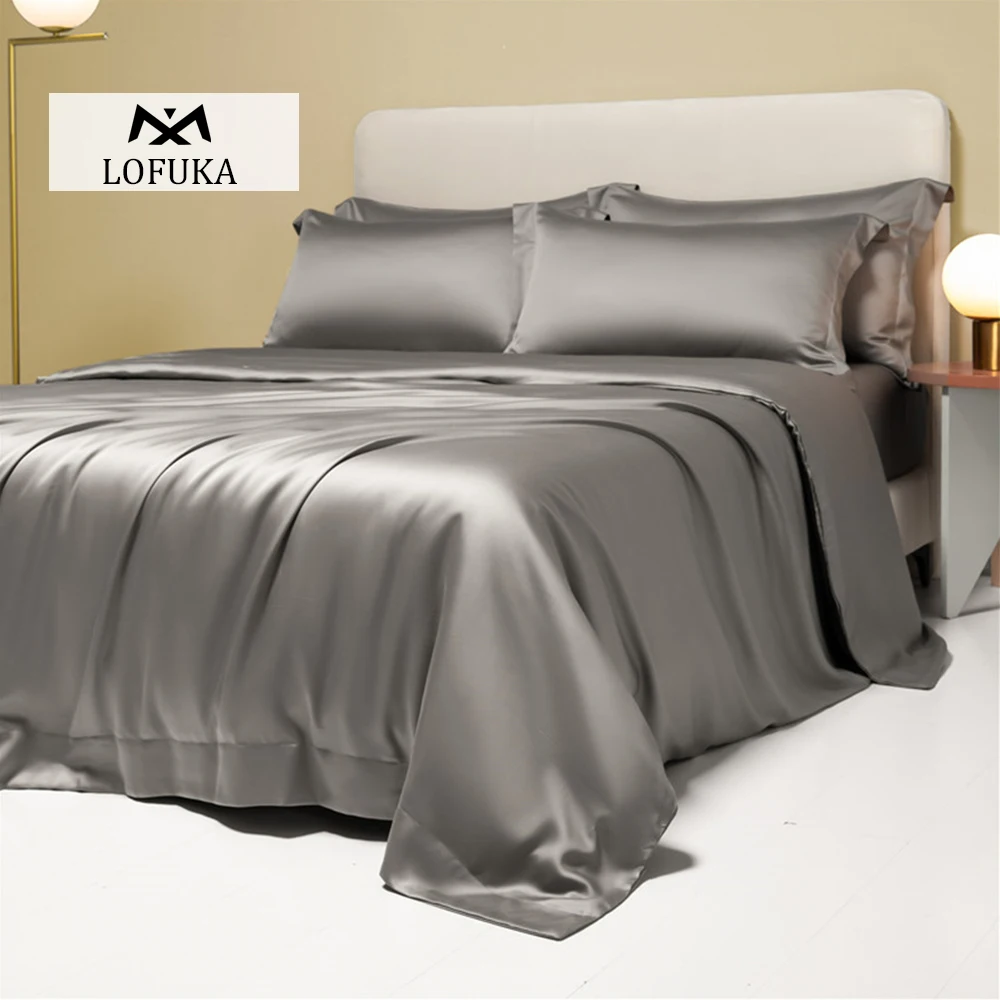
Full-size Silk Sheets, King Size Silk Sheets, Queen Size Silk Sheets, Twin Size Silk Sheets, Washable Silk Sheets
Price range: $95.95 through $178.37 Select options This product has multiple variants. The options may be chosen on the product page100% Silk Sheets, Green Silk Sheets, King Size Silk Bedding Set, Mulberry Silk Bedding Sets, Queen Size Silk Bedding Set
Price range: $1,246.21 through $1,615.22 Select options This product has multiple variants. The options may be chosen on the product pagePink Silk Sheets, Twin Size Silk Sheets
$171.80 Select options This product has multiple variants. The options may be chosen on the product pageFull-size Silk Sheets, Pink Silk Sheets
$136.31 Select options This product has multiple variants. The options may be chosen on the product pageFull Silk Bedding Set, King Size Silk Bedding Set
Price range: $120.99 through $190.49 Select options This product has multiple variants. The options may be chosen on the product pageGrey Silk Sheets, Silk Sheet and Pillowcase Set
Price range: $88.20 through $146.64 Select options This product has multiple variants. The options may be chosen on the product page
Understanding Momme Weight and Seasonal Comfort
When selecting silk bedding for year-round use, understanding momme weight becomes essential. Momme (pronounced “moh-mee”) is the standard measurement of silk weight and density – similar to thread count in cotton but far more meaningful for silk quality assessment.
Momme weight refers to the weight in pounds of a piece of silk fabric measuring 45 inches by 100 yards. In practical terms, higher momme numbers indicate heavier, denser silk with more silk protein per square inch. Understanding silk momme weight helps you select the ideal weight for your specific needs and regional climate.
For year-round comfort in most climates, the ideal range falls between 19-25 momme. This “sweet spot” provides several key benefits:
- Sufficient weight for durability and opacity
- Enough substance for effective insulation in winter
- Not too heavy for breathability in summer
- Optimal balance of softness and structure
Different momme weights do offer varying seasonal advantages. The silk momme weight guide explains these distinctions in detail, but here’s a simplified breakdown:
| Momme Range | Summer Performance | Winter Performance | Durability | Best For |
|---|---|---|---|---|
| 16-19 | Excellent (very lightweight) | Good (may need additional layers) | Good | Hot climates, hot sleepers |
| 19-22 | Very good (lightweight) | Very good | Excellent | Year-round use in most climates |
| 22-25 | Good | Excellent | Excellent | Year-round use, cooler climates |
| 25-30 | Moderate (may feel warmer) | Excellent (substantial warmth) | Superior | Cold climates, cold sleepers |
While extremely lightweight silk (below 16 momme) might feel wonderful in peak summer heat, it typically lacks durability for year-round use. Similarly, very heavy silk (above 30 momme) provides exceptional winter warmth but might feel too substantial during hot summer nights.
The practical differences between these weights are noticeable but subtle. A 19-momme sheet feels light and crisp with excellent drape, while a 25-momme sheet has more substantial weight and a slightly more luxurious feel. Both will regulate temperature effectively, but the heavier option provides marginally better insulation in cold conditions.
For most households seeking true year-round bedding, the 19-22 momme range represents the ideal balance – substantial enough for durability and winter warmth while remaining light enough for summer comfort. This range allows you to maintain the same bedding throughout seasonal changes with minimal adjustments to additional layers.
Caring for Silk Bedding Across Seasons
Proper care ensures your silk bedding maintains its temperature-regulating properties and extends its lifespan across all seasons. While silk is more durable than many people realize, its care requirements do vary slightly with seasonal conditions.
During humid summer months, the primary concern becomes preventing mildew or mold. After sleeping on silk bedding in hot weather, allow it to air out for 15-20 minutes before making your bed. This brief airing prevents moisture accumulation that could eventually damage fibers. In particularly humid climates, occasionally placing silk bedding in indirect sunlight for 20-30 minutes can help eliminate excess moisture – but avoid direct sunlight which can fade colors and weaken fibers.
Winter brings different challenges, particularly static electricity in dry heated environments. To combat winter static, avoid over-drying silk bedding and consider using a humidifier in your bedroom. A light spray of anti-static solution formulated for silk can also help during the driest months. The exceptional benefits of Mulberry silk sheets include less static than synthetic materials, but extremely dry conditions can affect even natural fibers.
Year-round care basics remain consistent:
– Wash in cold water using mild detergent specifically formulated for silk
– Avoid bleach, fabric softeners, and enzyme-containing detergents
– Hand wash or use washing machine’s gentle cycle in a mesh laundry bag
– Air dry or use dryer’s lowest heat setting
– Iron only if necessary, using the silk/low heat setting with a cloth barrier
When storing unused luxury silk bedding sets between seasons, avoid plastic containers which can trap moisture. Instead, store in breathable cotton bags or acid-free tissue paper in a cool, dry place away from direct sunlight. Before storage, ensure silk is completely dry to prevent mildew development.
Seasonal refreshing can help maintain silk’s natural properties. Occasionally airing bedding outside (in shade) can rejuvenate fibers and eliminate any lingering odors. For winter storage of summer-weight items, adding a natural cedar block rather than mothballs provides pest protection without harsh chemicals that might damage silk fibers.
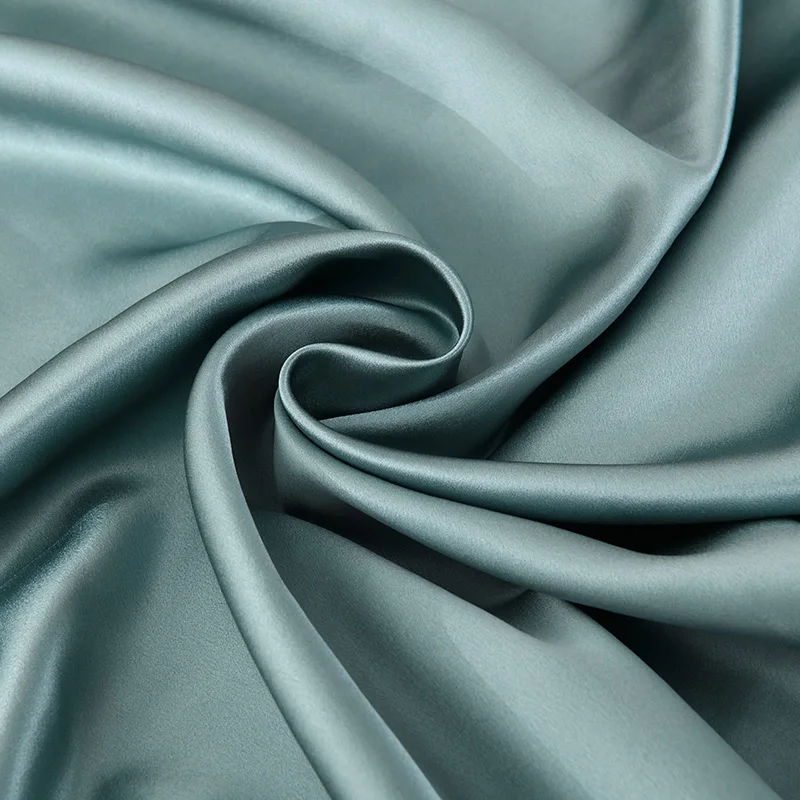
Common Misconceptions About Silk Bedding Addressed
Despite silk’s long history as a premium bedding material, several misconceptions persist about its practicality and seasonal appropriateness. Addressing these myths helps clarify why silk makes an excellent year-round bedding choice.
“Silk is too delicate for everyday use”
While silk requires appropriate care, quality silk bedding (19-25 momme) is surprisingly durable. Modern manufacturing techniques have enhanced silk’s strength while maintaining its luxurious feel. Many choose Mulberry silk sheets specifically for their durability – properly maintained silk bedding can last for many years of regular use. The natural protein fibers actually become softer with proper washing while maintaining structural integrity.
“Silk is only suitable for summer/winter”
This common misconception fails to recognize silk’s unique thermoregulating properties. Unlike cotton (which excels in summer) or flannel (which works best in winter), silk’s protein structure automatically adapts to body temperature and environmental conditions. The same properties that make silk cool in summer – breathability and moisture-wicking – contribute to its warming properties in winter when combined with its natural insulation capacity.
“Silk bedding requires professional cleaning”
Modern silk bedding can typically be hand washed or machine washed on gentle cycles with appropriate silk detergent. While dry cleaning was once recommended, today’s silk care has simplified considerably. Most quality silk bedding includes detailed care instructions that make maintenance straightforward for the average household.
“Silk is too expensive to be practical”
While silk’s initial purchase price exceeds that of basic cotton bedding, its longevity offers better value over time. When assessed on a cost-per-use basis over its full lifespan (often 5+ years with proper care), silk becomes more economical than repeatedly replacing lower-quality bedding. Additionally, silk’s year-round usability eliminates the need for multiple seasonal bedding sets.
“Silk feels slippery and will slide off the bed”
Today’s silk bedding often incorporates design features that address this concern. Many silk fitted sheets include elastic all around (not just corners) for secure placement, while duvet covers typically feature ties or closures to keep inserts in place. Additionally, the “slippery” quality varies significantly with momme weight – 22-25 momme silk provides a more substantial feel with less slide than very lightweight options.
The Environmental Benefits of Year-Round Silk Bedding
Beyond personal comfort, silk bedding offers several environmental advantages worth considering, particularly when used year-round as a single bedding solution.
Perhaps the most significant environmental benefit comes from reduced consumption. The average household maintains multiple bedding sets for different seasons – typically cotton for summer, flannel for winter, and transitional options for spring and fall. By investing in a single set of silk bedding that works year-round, you significantly reduce resource usage and textile waste. This “buy less, buy better” approach aligns with sustainable consumption principles.
Silk’s biodegradability presents another environmental advantage over synthetic alternatives. As a protein fiber (similar to wool or hair), silk naturally decomposes at the end of its usable life, unlike polyester or microfiber bedding that remains in landfills for hundreds of years. When silk eventually wears out, it returns to the earth without contributing to long-term waste problems.
The energy efficiency aspects of silk bedding also deserve attention. By naturally regulating temperature, silk bedding can reduce reliance on heating and cooling systems. Many users report setting their thermostats 1-2 degrees higher in summer and lower in winter after switching to silk bedding, as the improved sleep microclimate reduces the need for artificial temperature control. This adjustment, while seemingly minor, can yield meaningful energy savings over time.
The eco-friendly silk bedding options available today often incorporate sustainable production practices. The mulberry trees that feed silkworms require minimal pesticides compared to cotton cultivation, and many producers now use environmentally responsible processing methods. When selecting silk bedding, looking for certifications regarding responsible production helps ensure your purchase supports sustainable practices.
Even silk’s longevity contributes to environmental benefits. By lasting years longer than lower-quality alternatives, silk bedding reduces the manufacturing, shipping, and disposal impacts associated with frequent replacements. This durability represents a form of sustainability often overlooked in discussions about “green” products.
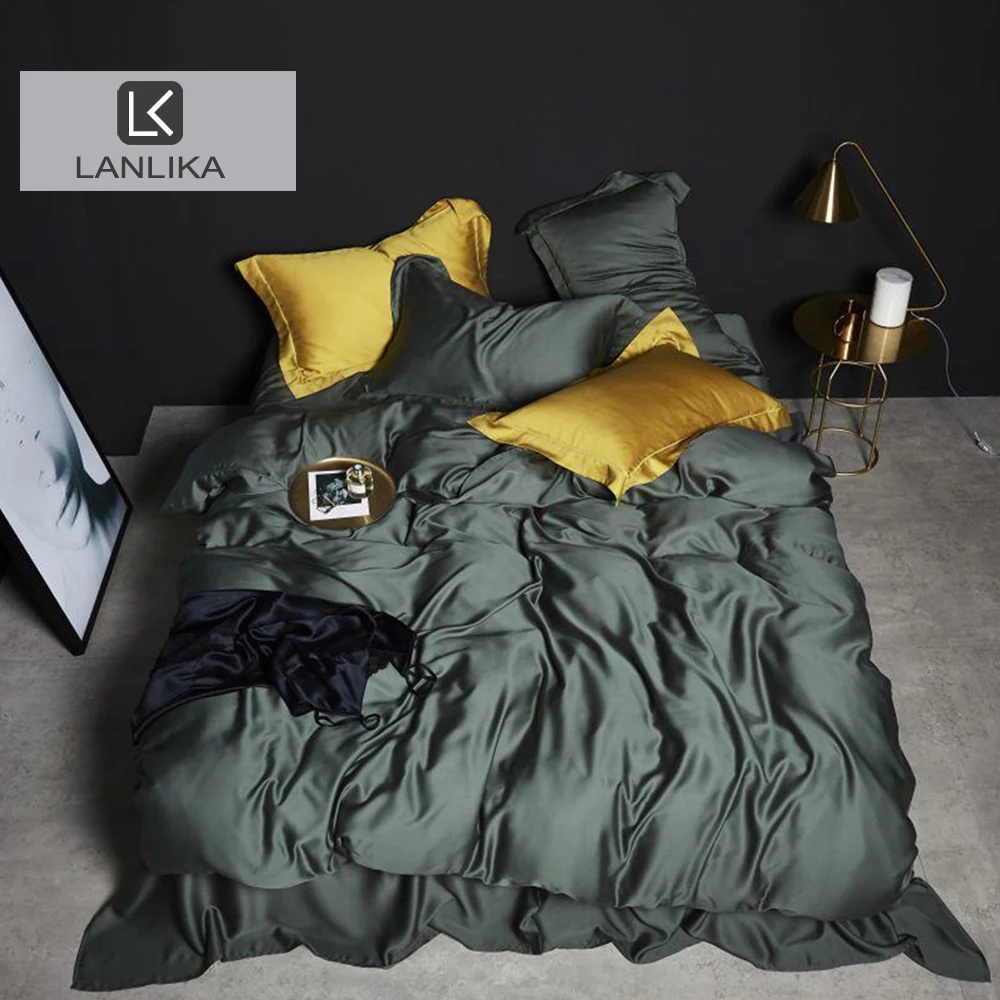
Conclusion: Investing in Year-Round Comfort with Silk Bedding
Throughout this guide, we’ve explored how silk bedding defies traditional seasonal limitations to provide exceptional comfort year-round. From summer’s heat to winter’s chill and the unpredictable transitions between, silk’s remarkable natural properties adapt to your body’s needs without requiring seasonal bedding swaps.
The science behind silk’s performance is compelling – a unique protein structure that simultaneously offers breathability, moisture management, insulation, and temperature regulation. These aren’t marketing claims but natural properties inherent to silk’s molecular composition, refined over thousands of years of silk cultivation and manufacturing.
Beyond temperature regulation, silk offers a comprehensive suite of benefits that remain valuable regardless of season: hypoallergenic properties, skin and hair health improvements, reduced friction, and exceptional durability. These advantages make silk not merely a luxury indulgence but a practical investment in your daily wellbeing.
The ultimate guide to silk bedding confirms what silk users have known for centuries – that this extraordinary natural material offers comfort unmatched by synthetic alternatives or other natural fibers. By choosing quality silk bedding in the appropriate momme weight for your needs, you’re investing in years of consistent comfort across seasons and weather conditions.
Whether you’re seeking relief from summer heat, cozy warmth in winter, or the perfect balance during transitional months, silk bedding offers a single solution that adapts as needed. This versatility, combined with silk’s exceptional feel and health benefits, makes it the ideal choice for those who value quality sleep as a foundation for overall wellness.
By investing in premium silk bedding, you’re not just purchasing sheets and pillowcases – you’re creating a sleep sanctuary that works in harmony with your body all year round, adapting to your needs night after night, season after season.


